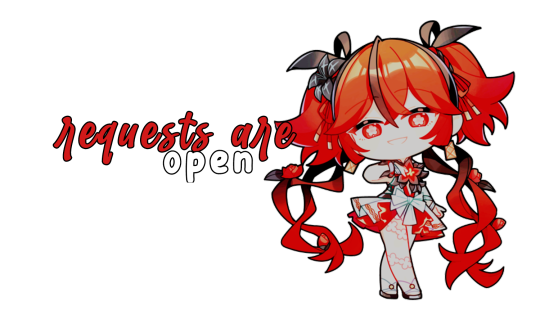#medically unrecognized disorder
Explore tagged Tumblr posts
Text



fictional reliance disorder (FRD)
> when one is heavily impacted by or heavily reliant on works of fiction. this includes;
holding views or beliefs that are mainly present in fiction/mainly based in fiction.
having unrealistic expectations of certain experiences.
relying heavily on works of fiction to function or prefering to interact with fiction over reality.
experiencing confusion or upsetness when something turns out different from the media they consume.
maladaptive daydreaming, if not daydreaming is still prevelant.
have an interest in creative arts such as drawing or writing.


#radqweer ♡ ིྀ ܀#cwoins ♡ ིྀ ܀#fictional reliance disorder#medically unrecognized disorder#mud coining#radq safe#pro transid#pro radq#radqueer#rq safe#rq 🌈🍓#rq 🍓🌈#rqc🌈🍓#rq community#pro rq 🌈🍓#radqueer 🍓🌈#radq please interact#radq interact
324 notes
·
View notes
Text

COMPULSIVE ARCHIVAL DISORDER (CAD) 📂
a Medically Unrecognized Disorder (MUD) characterized by episodes or behaviors of compulsive archiving of objects of fascination or interest. this can include information about people, fictional media, nonfictional media, history, images, files, etc.

SUBTYPES
Constant Compulsive Archival Disorder (C-CAD)
Infrequent Compulsive Archival Disorder (I-CAD)

SYMPTOMS
— obsession over containing information about their object of fascination.
— compulsive archiving of seemingly irrelevant media.
— urges to archive things in fear of it being lost or unavailable in the future.
— compulsive hoarding (digital or physical).
— distress or discomfort from the idea of, or attempts at, breaking away from archival.
— struggling to break away from archiving / hoarding habits.
#・ mankinds new habit#・ refleshing the mutt#SORRY IF THIS IS KIND OF SHIT#FIRST TIME DOING THIS YOU KNOW#pro rq 🌈🍓#rq 🌈🍓#rqc🌈🍓#medically unrecognized disorder
287 notes
·
View notes
Note
could you possibly coin something similar to MIID except instead of it being one's reflection, it's with the image of a character they strongly identify with or as (whether in an alterhuman way, a system way, or a transid/cis id way)
》 @radically-katrielle

CHARACTER AFFINITY IDENTITY DISORDER





— What is it ?
Character Affinity Identity Disorder (CAID) is a condition where an individual strongly identifies with a specific character's portrait, to the point where their sense of self becomes deeply intertwined with that character’s traits or persona. This can lead to emotional overlap, confusion about personal identity, and difficulty functioning outside of the character, often causing distress or anxiety when not embodying them .
— Symptom List :
Intense Identification : A persistent and overwhelming sense of self being tied to a specific character's portrait, to the point where their traits, appearance, or life experiences feel deeply aligned with the individual’s own identity . Emotional Portrait Attachment : A strong, almost uncontrollable urge to look at images or representations of the character, often for reassurance, comfort, or to reinforce the identity connection . Inconsistent Self-Perception : Shifts in self-perception, where the individual may struggle to define who they are outside of the character, feeling lost when not expressing or identifying as them . Dysphoria or Anxiety : Feelings of discomfort or distress when unable to embody or express the character, leading to anxiety or a sense of disconnection from one’s own identity . Altered Social Interactions : Difficulty engaging in social environments as their “real” self, preferring to present or embody the character’s traits or persona in interactions .
— Treatment ?
Unlike MIID , CAID isn't as easily treatable .
While potentially addressed with some therapeutic methods, may be less straightforward to treat due to the deeply ingrained nature of the identity attachment to the character. Unlike MIID, which might respond well to behavioral therapies that help individuals dissociate from their reflections, CAID may involve more complex layers of identity formation, possibly including dissociation or a strong alterhuman, system, or trans/cis identity component. In cases where CAID is more about a deeply rooted sense of self, treatment may be longer-term or focus on integration techniques that help the person understand and navigate their identity without fully relying on the character.
@ credits to armyflags for the flag < 3

#— Nurse' s Check-Up#medically unrecognized sickness#medically unrecognized disorder coining#medically unrecognized disorder#transid coining#pro radq#radq safe#radqueer#radqueer community#radqueers please interact#pro rqc#radq coining#radq interact#radqueer coining#pro radqueer#rq community#rqc#transid community#transid#transid safe#pro transid#transid positivity
153 notes
·
View notes
Text

SUBJECT FASCINATION DISORDER
(SFD)
A Medically Unrecognized Disorder characterized by the unadulterated need to investigate and or study people in the likes of a test subject.
People with this disorder oftentimes struggle with their identity due to confusion of interests and self. They may also have a difficult time forming relationships, as infatuation is confused with genuine bonds.
#radqueer#rq#rq 🌈🍓#transid#transid coining#rq community#rq please interact#transdid#medically unrecognized disorder
325 notes
·
View notes
Text
Poneros- flags.
Etymology: poneros, meaning wicked/evil.
Poneros -phobia, -mania, -philia



Ponerosphobia: the abnormal and irrational fear of being evil and being perceived as evil.
Ponerosmania: the extreme obsession with being evil and being perceived as evil.
Ponerosphilia: the paraphilic attraction to being evil and being perceived as evil.
#paraphilia flags#medically unrecognized disorder#phobia flags#rq community#rqc#pro para#radqueer please interact#paraphiles please interact#pro paraphile#radqueer#pro radq#radq safe#radq interact#radq please interact#pro rq 🌈🍓#rq 🌈🍓#rq 🍓🌈#rqc🌈🍓#rq safe#radqueer 🌈🍓#🍓🌈#radqueer 🍓🌈#pro 🍓🌈#rqc 🍓🌈#🍓🌈 safe
65 notes
·
View notes
Text




🌹﹕Floravexia Disorder (FVD)
Floravexia Disorder (FVD) is a medically unrecognized disorder (MUD) characterized by an overwhelming, almost obsessive compulsion to "bloom." Either mentally, emotionally, or physically in a way that mimics the life cycle of a flower. Individuals with FVD believe they are trapped in a cyclical process of growth, blooming, and eventual decay, mirroring the seasons of a flower's life. This disorder causes a person to experience profound emotional highs during their "blooming" phase, followed by deep depressive lows during the "wilting" phase. The condition affects their perception of self-worth, relationships, and their overall purpose in life, leading them to chase constant renewal or change.
Symptoms include;
Individuals with FVD experience intense periods of euphoria and creativity, where they feel as though they are flourishing, or "blooming", into their fullest potential. During these phases, they may feel invincible, productive, and highly connected to the world around them. They might take on new projects or engage in relationships with a sense of grandeur or passion.
After their "blooming" period, individuals experience a rapid decline akin to the wilting of a flower. This phase is characterized by feelings of worthlessness, exhaustion, and isolation. They may feel that their efforts, whether personal, social, or creative, are futile, and become disillusioned with their previous highs.
People with FVD often feel the urge to reinvent themselves constantly, much like a flower that blooms anew with each season. This can manifest as dramatic changes in appearance, career, relationships, or even personality, driven by the need to feel alive, fresh, or renewed. However, this reinvention often leads to a lack of continuity in their life, making it difficult to build lasting connections or careers.
In more severe cases, individuals may experience vivid hallucinations of flowers, plants, or growing phenomena. These can range from seeing flowers where none exist to experiencing the sensation of literal growth on their skin or inside their body. These hallucinations can be distressing, particularly when they occur during the wilting phase.
Some individuals experience cyclical patterns of blooming and wilting that correspond with seasonal changes, making the disorder feel like a natural, but uncontrollable, force of nature. This can create an ongoing struggle for those affected, as they may feel trapped by the cycles of emotional highs and lows.
TAGGiNG : @mudarchive
#camellyas coins#medically unrecognized disorder#medically unrecognized sickness#pro transid#rqc🌈🍓#pro rqc#transid safe#pro radqueer#transid#radqueer safe#rq community#rq interact#rq please interact
103 notes
·
View notes
Text

Self-Destructive Identity Disorder (SDID) flag
MUD coined by @the-garden-mud-blog
Flag made by me
#pro transid#pro para#radqueer#pro transx#pro radqueer#transid safe#mud flag#flags#medically unrecognized sickness#medically unrecognized disorder#pro rq#pro rq 🌈🍓#pro radq#pro mud#rq community#radq safe#radqueers please interact
159 notes
·
View notes
Text
It’s Coining Time!

Glitching Mind Disorder (GMID)
Glitching Mind Disorder is someone who’s mind has a constant static, numbing, or null mind. This can be connected to a trauma, pass on genetic trait, or gained later on in one’s life.
symptoms contain : Mind having a constant hazing or null/blank state A struggle to consecrate even on simple tasks Fluctuating between too many thoughts to none at all Forgetfulness Easy to misunderstand and not process information
no flag : if one is made I’ll repost it! I do not plan to take requests at this time. But I hope you enjoy.
#steven mudverse#muds 🌟#👁️📝#🧠📝#medically unrecognized disorder#wet dirt#mud coining#mud term#rq 🍓🌈#🍓🌈 safe#radqueer#Glitching Mind Disorder#GMID
199 notes
·
View notes
Text
Musically Aided Alexithymia (MAA)


Musically Aided Alexithymia (MAA) is an MUD and a subtype of alexithymia where individuals express typical symptoms of alexithymia, but have music-related symptoms as well.
Symptoms include:
A. Being unable to label any feelings that aren't big and obvious (Eg depressive & manic) but knowing they're vaguely 'sad', 'angry', 'happy' etc.
B. Only being able to label said feelings with songs, not that the song talks about a feeling or outright has any obvious tones other than a specific brand of 'sad', 'angry', 'happy' etc that only that song can convey.
B1. Above may be related to 'Feelings-to-music' synesthesia, or vice versa.
#musically aided alexithymia#medically unrecognized disorder#mud term#mud coining#radqueer safe#radqueer community#radqueer 🍓🌈#pro radqueer#radqueer coining#radqueer 🌈🍓#rq safe#radqueer#rqc🌈🍓#rq 🌈🍓#rq 🍓🌈#pro rq 🌈🍓#pro rq#pro rq 🍓🌈#rq coining#rq community#rqc#rqc 🍓🌈#rqc 🌈🍓#✧ eclipse coins#✧ type: mud
113 notes
·
View notes
Text
SLENDER SICKNESS (SLSI)



What is Slender Sickness?
Slender Sickness is a Medically Unrecognized Sickness stemmed from encounters with , sightings of , and stalking from Slenderman.
The sickness progresses in stages as one continues to encounter Slenderman.

Subtypes & Symptoms
— SLSI-1 (Stalking Stage) :
A subtype of SLSI stemmed from being stalked by Slenderman.
Characterized by nosebleeds alongside a fever like the common cold , infrequent amnesia.
— SLSI-2 (First Encounter Stage) :
A subtype of SLSI stemmed from a direct , first encounter with Slenderman.
Characterized by nosebleeds , migraines , exhaustion , nausea , heavy cough , amnesia , vomiting , typical signs of radiation poisoning , aching and pains with no origin , trauma to the eyes ( such as bloodshot , vesial popping , etc )
— SLSI-3 (Frequent Sighting Stage) :
A subtype of SLSI stemmed from repeated ( 5+ ) encounters with Slenderman.
Characterized by coughing up blood , vomiting blood , increased signs of exposure to radiation , difficulty breathing , difficulty swallowing , violent and sudden convulsions , major frequent amnesia.
#・ listen well#・ mankinds new habit#pro rq 🌈🍓#rq 🌈🍓#rqc🌈🍓#medically unrecognized disorder#medically unrecognized sickness#xenomalady#transid
67 notes
·
View notes
Text

MIRROR INFATUATION IDENTITY DISORDER





— What is it ?
MIID is characterized by the infatuation with one's image in the mirror , with the individual not being able to pry their eyes off and seemingly almost in a trance with their own reflection .
— Types :
Mirror Infatuation (Obsession) Identity Disorder : A specific set of MIID , where the reason behind an individuals infatuation isn't directly understood - other than that the individuals is over obsessed with their looks. Individuals with this disorder will often blankly stare at themselves , often fix their appearance in small ways , and even obsessively take pictures of themselves . Mirror Infatuation (Self Esteem) Identity Disorder : A specific set of MIID , where the reason behind an individuals infatuation is centered around a low self-esteem and body dysphoria. Individuals with this disorder are often noticed to be sulking about their reflection , as it actively upsets them - yet they cannot help but continue to stare.
— Symptom List :
Inability to pry eyes away from mirrors : Most often happens in social settings , people with MIID have the ability to be indulged in a conversation while also be infatuated by their reflection at the same time as a form of multitasking . Sense of distress from not having seen oneself : Individuals with MIID tend to have feelings of anxiety after not seeing their reflection in a period of time - often linked with the fear of how one looks or even not being able to imagine how they look anymore. Inability to pry eyes away from mirrors : Also called " Mirror Locking " , is the period of time when an individual dissociates at their reflection and physically cannot pry their eyes away . This can be distressing , and lead to meltdowns .
— Treatment ?
Individuals with this disorder have the ability to fully recover with the right environment ! - Help with self esteem : often the first go to for MIID (especially for MI(SE)ID) , treatment for body dysmorphia with bettering one's relationship with their reflection has had great results . - Limiting mirrors in social settings : Being reminded of an individuals conversation topic , being more observant of their surroundings can often help with ignoring the need to look at oneself in the mirror . Things like covering mirrors with cloth , or fully avoiding them for small periods of time is also recommended . - Overcoming the anxiety : MIID individuals often feel anxiety from not perceiving themselves for a long period of time , so having small hand held mirrors is often advised - they are small which makes it hard for the individual to fully observe themselves , and it being hand held will force them to put the mirror down after their hands get sore .
@ credit to @armyflags for the flag <3

#— Nurse' s Check-Up#medically unrecognized disorder#medically unrecognized sickness#mud coining#transid coining#mus coining#pro radq#pro rqc#radq coining#radq interact#radq safe#radqueer#radqueer community#radqueers please interact#transid safe#transid#pro transx#transx safe#transid please interact#transid community#transid pride#rq 🍓🌈#radqueer 🍓🌈#pro 🍓🌈#rqc 🍓🌈#🍓🌈 safe#🍓🌈 rq#pro rq 🌈🍓#rq 🌈🍓#radqueer 🌈🍓
117 notes
·
View notes
Text
🔥🌋﹕burnt commitment disorder◞ (BCMD)


BCMD is an MUD (medically unrecognised disorder) for those that commit to things they're sure they want (eg. social media accounts, relationships, online identities) and then panic once they're in "too deep" and abandon the responsibility, often then taking up similar (or completely different) ones after, similar to the action of burning something down and starting anew.

symptoms + diagnostic criteria﹕
Committing to things that feel fun and enjoyable at the time, but quickly dropping them in a panic.
Often feeling as if you're in over your head with responsibilities
Feeling as if everythings spiralling out of control whenever you're apart of something, even when it's things other people seem to deal with daily just fine.
Often disappearing off the face of the internet/earth only to come back a few months later with a new account/personality

#wet dirt#medically unrecognized disorder#medically unrecognized sickness#transid#pro transx#transx community#transdisabled#radqueer#pro radqueer#radq safe#🌸﹕coining !
75 notes
·
View notes
Text

Xeno Personality Disorder
For when you have a personality disorder in a new/unknown way or a way that can't be defined by pre-existing terms. Could be considered a mud if you want, also could be a transid. It's a xenoid so you get to pick
You can shorten it to XPD or make new terms like idk catPD or sparklePD if you wanna
I know xeno-bpd has been coined but there's no terms for pds in general so :p
#💽 . . . clear cache?#pro rq 🌈🍓#rq coining#wet dirt#medically unrecognized disorder#rq community#transid#transid coining#<- maybe
131 notes
·
View notes
Text
Episodic Water Dependency [Disorder] [EpWD or EWDD]

Definition: A disorder characterized by having episodes of extreme water dependency that cause discomfort, distress, stress, and/or depressive thoughts, feelings, or actions. These emotions often result in impulsive or compulsive actions in order to be in, near, or consume water/another liquid. [this could also be used as a symptom or aspect of another disorder]
[tw: mentions sh and suicide below]
[Ones Dependent Liquid or DL may vary however this Disorder was made with water in mind… you could call it ELDD, Episodic Liquid Dependency Disorder if you wish or if that fits better]
Symptoms/Criteria:
1) Distress, discomfort, dysfunction, stress, or dysphoria when one has not been in, near, or in—some cases—consumed water/their DL[dependent liquid] recently.
2) Having a strong connection to water or your DL[dependent liquid] that may intertwine with various aspects of ones identity.
3) during an episode being unable to function/experiencing a difficulty in functioning when one has not come in contact with water or their DL[dependent liquid] for short or extended periods of time [this can be as long as a month or as short as a few minutes].
4) [If one experiences sensory differences] having ones sensory issues get worse during episodes where they have not had contact with water or their DL for an extended or short time.
6) experiencing depressive episodes, suicidal and/or self-harm induced thoughts/actions, or similar during/as a result of water dependency episodes. One could also turn to water/their DL for the answer/solution to problems.
7) Having these symptoms and experiences be more extreme than typical water/liquid dependency.
8) noticing episodic patterns for at least 3 months; an episode, worsening of symptoms, or development of this disorder may occur for a variety of reasons such as external factors like stress or fear as well as internal factors such as self-esteem, brain chemical levels, and/or other mental health problems.
9) Fear or distress caused by being dirty or feeling like your dirty even if you’ve recently showered, bathed, or washed off.
Possible causes, triggers, and risks:
1) The cause/causes for this disorder are unknown however possible causes may include:
- Neglect
- Being without proper ways to clean/clean oneself fro extended periods of time
- Low-self-esteem or poor mental health
- Paranoia or a fear of germs
2) You may be more at risk if you have another mental health disorder/syndrome such as Major Depressive Disorder, Bipolar Disorder, OCD, DPD, PTSD, etc. etc.
3) Common triggers for an episode include but are not limited to; overwhelming / intense emotions, stressful and / or traumatic events, being away from running water / water / their DL, being unable to wash yourself, etc.
4) Some of the possible risks that come with EpWD[D] is:
- Becoming overly dependent on water/your DL and running the risk of it becoming an addiction.
- Being unable to function or get work done because of distress, stress, or discomfort surrounding feeling messy/unkempt -OR- being unable to work or function because you’re too caught up cleaning yourself and surroundings.
- A disconnection in relationships as they don’t/wouldn’t understand and/or feeling too stress/distressed/uncomfortable to make strong bonds and connections

This term can be used by anyone // we have no DNI so neither do our coins // please follow your own DNI
As long as you use this term in good faith [genuinely, not as a joke or troll] we will have no problems as it is not our place to tell you what to do.
if this term or something similar has been coined prior to this consider it a recoin / redesign as we often do not know or realize

#medically unrecognized disorder coining#medically unrecognized disorder#wet dirt#wet dirt coining#‧₊˚✧ new circus acts ✧˚₊‧#Episodic water dependency#Episodic water dependency disorder#disorder coining
50 notes
·
View notes
Text
The New Archive is ready!
So for months I have been working on a new neocities mud archive to replace the inactive mud rentry as the primary resource for MUDs.
I am happy to say it is now ready for release!
Important note: It is not fully up to date yet. I am still working on it and will announce when it is. I am releasing it now as it officially has more MUDs than the inactive rentry so is still a more complete resource.
My future plans for this archive (in the order I currently plan on doing them):
Bring it fully up to date
Write a much more fleshed out info section
Research P-MRDs and F-MRDs so I can give them proper sections
I know it's not exactly the fanciest looking website but it is functional and I have worked very hard on this so I really hope you like it!
#medically unrecognized disorder#xenomalady#archive update#radqueer#mud community#mud archive#pro rq 🌈🍓#rqc🌈🍓#rq 🌈🍓#rq safe#pro radq#pro radqueer#radqueer community#radqueer safe#radq safe#rq community#mupd#radq please interact
40 notes
·
View notes
Text

Kurai Syndrome (KS) OR Chronic Identity Hoarding Syndrome (CIHS)
*Sometimes also colloquially referred to as ‘Collector’s Syndrome.’
Kurai Syndrome is a medically unrecognized syndrome that leads to severe anxiety surrounding the way one is perceived, both by oneself and by others, while also causing strong feelings of attachment to and a pathological search for labels. Named for Kurai Ikeda of Cathedral Astroplex, who reported feeling a constant and distressing need for more personal labels.
In order to have Kurai Syndrome, one must fit the following criteria;
Strong discomfort, unease, or anxiety regarding how one is viewed or how one views oneself.
Pathological and pervasive need to curate one’s external presentation to others.
Distrust of oneself to accurately portray one’s experiences without language that is ‘just right’ or all-encompassing.
Envy of or frustration with those who feel comfortable in simple or vague identities.
Constant desire for new language to describe or refer to oneself.
Fleeting feelings of emptiness or bouts of depression when one cannot find new identities to take on.
Kurai Syndrome has three (3) subtypes.
Generalized Chronic Identity Hoarding Syndrome, or G-CIHS
When one’s anxiety surrounding one;s identity impacts all aspects of said identity. A combination of all (applicable) listed subtypes. This is the most common observed subtype as of February 2025.
Localized Chronic Identity Hoarding Syndrome, or L-CIHS
When one’s anxiety surrounding ones identity impacts one particular aspect, such as name, gender, or diagnoses.
Multi-Localized Chronic Identity Hoarding Syndrome, Complex/C-CIHS, or MultiCIHS
When one’s anxiety surrounding one’s identity impacts multiple but not all aspects of one’s identity.
Associated Features
When Kurai Syndrome is comorbid with personality disorders, particularly DPD and HPD, or with obsessive disorders, individuals with the disorders will latch onto one person to supply them with new identity labels, which are often called idea factories of identity crafters.
Risks and Prognostics
The cause of Kurai Syndrome is not known at this time, however, it has been noted to have higher prevalence within nonsinglets and transidentity-using individuals.
Comorbidities
Due to the nature of the disorder, it is impossible to accurately state what can or cannot be comorbid with Kurai Syndrome. High rates of both disordered and non-disordered plurality can be found among those with Kurai Syndrome, as well as other anxiety or panic disorders, hoarding problems, and, in much lower rates, substance abuse. Hypochondria is also highly common.

#transid#pro rq 🌈🍓#endogenic#medically unrecognized disorder#pro para#wet dirt#rqc🌈🍓#rq community#rq 🌈🍓#rq safe#radqueer#pro paraphile#paraphilia#paraphile safe#medically unrecognized sickness
32 notes
·
View notes